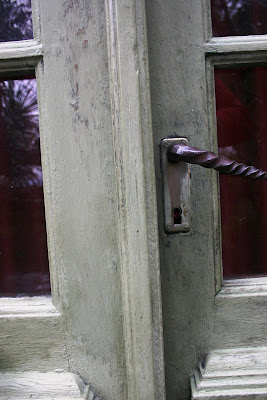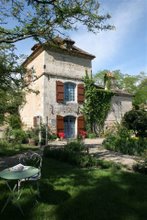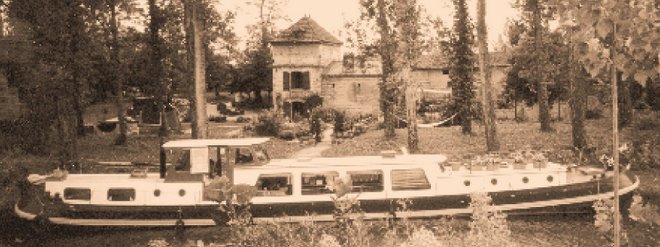February 19, 2009
February 10, 2009
Confit de Canard. Duck Confit...part 3- 7 French Tips
Time Warp Portal
Catou and France weave a magic spell over all who enter their treasure house domain, whether they arrive to scout the antiques and brocante at the barn and stable shops or come in friendship to share their convivial hospitality at the oversized kitchen table. Today, a small band of visitors and local residents descended to 'help' in their annual fat duck weekend and I came as part reproter, part culinary spy, eager student and grateful guest.
I reveled in being in company with gastro-friends and these timeless cooks. We were just seven of us, wearing wonderful homemade butchers' aprons to butcher, trim and cook the seven fatted ducks supplied by a neighbor. But I knew I was in the presence of generations of excellence in this kitchen: a butcher father, a frugal grand-mere, a great-grandfather who was a chef in a renowned Paris restaurant. The room was crowded with history and kitchen lore as if these smoky yellow walls who had witnessed centuries of recipes and trucs or tips were inspiring us.
Catou demonstrated her sure hand, warned us not to sacrifice the foie gras, and made the rounds of the table conjoling, correcting and scolding us in turn. We took our work seriously. After all, this would be their food for the year. Instructions were delivered brief, fast and with barely a heartbeat between breaking down the neck, breasts, legs, wings before 'birthing' the ivory firm liver each weighing in just under a pound. Hearts, gesiers or gizzards all got salted and added to the growing pile of meat. The carcasses themselves were quartered as we fought, caressed, and jointed the 15-pound birds with knives, secateurs and bare hands.
Leaving the meat to rest overnight in a cold pantry under a veil of delicate salt and wrapped in a pristine linen sheet, we retired to Greg's own medieval Manoir d'Orr in Lauzerte for a Saturday supper of sweet potato soup, Boeuf Caducienne cooked slowly in Cahor's delicious black wine, a pair of perfect cheeses and a perfect pear almond tart.
Saturday morning we returned to Chateau de Gayrac just as the fat and trimmings from yesterday were put over a very slow flame. From my notes:
11:00- fat trimmings and half glass of water go into a large aluminum caldron over a very low flame protected by a cast iron hob.
11;15- the duck legs are added 4 at a time to the barely melting fat so that they, too, can render their fat to the cauldron. They are placed upside down into the pan so that the fat forms an insulative cushion from the heat.
11;40- all the legs are now in the pan and slowly cooking over the lowest heat...it's not even simmering.
11:45- the manchons or wings are now added.
STIR CONTINUALLY lifting the meat off the bottom so it doesn't stick.
12:00- add gesiers or gizzards
12:15- seven hearts are added
12:30- the fat is only just now starting to simmer
12:45- begin to add the carcasses cut into quarters along with the wing tips
1:00- stir, stir, stir
1:15- begin to remove the legs if done and drain
1:30- continue to cook and stir all pieces until completely cooked.
The confit, once drained, is then placed into aluminum freezer boxes and stored in the freezer. Catou uses a pair fo garden shears or secateurs to snap the knob end of the bone off the leg. This makes it a tidier package not just for storing but for serving as well. The legs are then covered in fat, cooled and then set in the freezer. Freezing the confit in its fat makes a very quick and easy alternative to sterilizing and canning and one that adapts well from this medieval chateau kitchen to your modern apartment.
So what did I learn working with these experts in their own French kitchen?
Seven things I learned to share with you:
- SLOW and even slower then I ever cook, the confit barely simmers for over 2 hours which results in a much more tender confit right away.
- STIR continually not just so the meat or skin doesn't stick to the bottom but to also help regulate the heat so all pieces are cooked evenly.
- CLIP the knob end of the leg bone off with a garden shears before storing.
- SALT the carcasses, too, after cutting into quarters and then confit. Eat the meat off the bone with the help of a little paring knife to scarpe off all the good bits. these flavorful quarters can also be added to soups, bean and lentille vertes.
- COOK the hearts and gesiers together, not forgetting to trim the gesiers of the scaly yellow tough skin on the inside surface.
- SOAK the foie gras in salted cold water to which a couple of tablespoons of vinegar as been added.
- SHARE this knowledge, these trucs, the traditions and table willingly. Preserve the information, make better cooks and educate a hungry audience for your own French Kitchen Table.
and from all of us...
Merci Sept Foie... Catou et France!
February 04, 2009
Confit de Canard. Duck Confit. Part 2- like meat loves salt.
Confire- French verb to preserve, conserve.
je confis tu confis il confit
'Nous confisons un canard avec quatre tetes.'
We are preserving a duck with four heads.
eh voila! for information about why 4 heads... see previous post.
It took me longer to download and then upload these pictures then it did to make the confit. Way too long! So when my students complain (or comment) that real cooking takes so long, I protest. The virtual world might make some things easier but not necessarily faster. Making Confit de Canard ( or Porc, d'Oie or even Poule- that's pig, goose and old hen) is all about slow cooking, but it needn't be a three day affair. A quiet morning catching up with emails will do while the meat simmers away in a deep pan of golden fat.
The first step after butchering the whole duck into pieces is to lightly salt the meat and let it sit overnight. 'Overnight' here means no more than 12 hours. Salt before you go to bed and be ready to cook in the morning, or salt at the crack of dawn and cook that evening. Salting for 24 hours (or longer!) is overkill. Keep in mind the size of your ducks (mine will weigh in at 6-7 kilos, that's 13-15 pounds each!), the length of time you will be cooking and the preserving the meat (After cooking for 1 to 1-1/4 hours, I typically jar and sterilize my cooked confit in winter and leave it in the pantry until summer and fall using up most of it before the next batch is seasonal made) and to what end ( I will serve confit legs and magrets or breasts solo with salad and fried potatoes in the summer, add to autumn cassoulets, and make soups and garbures from the little peices of necks and wings.). More salt and longer salting time was necessary when confit was put up in earthenware jars and stored unrefrigerated in 'caves' or cellars. If you are not using traditional large fatted ducks (take a look at the size of the legs in my size 8 garden glove hand!), then scale down salt and cooking time.
These are the photographs on Flickr of the steps taken to get from fresh raw duck...
to succulent duck confit.
I'll get the descriptions on Flickr written up as soon as I get a minute between real life chores. This week, you'll notice that I put the confit in 2 jars, the necks into a crock, the extra fat in jam jars and then into the refrigerator rather than sealing and sterilizing them like I do usually. I'll be testing them in 2 weeks time for tenderness; we'll talk about aging the confit soon. In the meantime, enjoy the process!
je confis tu confis il confit
'Nous confisons un canard avec quatre tetes.'
We are preserving a duck with four heads.
eh voila! for information about why 4 heads... see previous post.
It took me longer to download and then upload these pictures then it did to make the confit. Way too long! So when my students complain (or comment) that real cooking takes so long, I protest. The virtual world might make some things easier but not necessarily faster. Making Confit de Canard ( or Porc, d'Oie or even Poule- that's pig, goose and old hen) is all about slow cooking, but it needn't be a three day affair. A quiet morning catching up with emails will do while the meat simmers away in a deep pan of golden fat.
The first step after butchering the whole duck into pieces is to lightly salt the meat and let it sit overnight. 'Overnight' here means no more than 12 hours. Salt before you go to bed and be ready to cook in the morning, or salt at the crack of dawn and cook that evening. Salting for 24 hours (or longer!) is overkill. Keep in mind the size of your ducks (mine will weigh in at 6-7 kilos, that's 13-15 pounds each!), the length of time you will be cooking and the preserving the meat (After cooking for 1 to 1-1/4 hours, I typically jar and sterilize my cooked confit in winter and leave it in the pantry until summer and fall using up most of it before the next batch is seasonal made) and to what end ( I will serve confit legs and magrets or breasts solo with salad and fried potatoes in the summer, add to autumn cassoulets, and make soups and garbures from the little peices of necks and wings.). More salt and longer salting time was necessary when confit was put up in earthenware jars and stored unrefrigerated in 'caves' or cellars. If you are not using traditional large fatted ducks (take a look at the size of the legs in my size 8 garden glove hand!), then scale down salt and cooking time.
These are the photographs on Flickr of the steps taken to get from fresh raw duck...
to succulent duck confit.
I'll get the descriptions on Flickr written up as soon as I get a minute between real life chores. This week, you'll notice that I put the confit in 2 jars, the necks into a crock, the extra fat in jam jars and then into the refrigerator rather than sealing and sterilizing them like I do usually. I'll be testing them in 2 weeks time for tenderness; we'll talk about aging the confit soon. In the meantime, enjoy the process!
Subscribe to:
Posts (Atom)



























